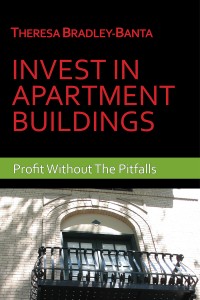Invest In Apartment Buildings: Profit Without The Pitfalls
Copyright © 2012 by Theresa Bradley-Banta
Published by Big Fish Top Dogs Publishing
Available at Amazon | iTunes | Barnes & Noble
The following is excerpted from my book Invest In Apartment Buildings: Profit Without The Pitfalls.
***
Location Is Everything
Some “experienced” investors would argue that timing trumps location. I’ve heard the gurus say, “Forget about location, location, location. It’s all about timing.” In fact I heard a speaker recently say this at a real estate convention I attended. I sat in the room and watched the attendees take fast and furious notes. My impression? The speaker was trying to act as though he was smarter than the rest of the class. Was he just being clever debunking what most real estate investors believe? Or did his remark convince 55 convention attendees location was not a critical consideration when investing in real estate?
Timing in investing is important. However if you buy a property in a bad location, you’ve got yourself a bad investment. It doesn’t really matter when you bought it. You might have a management nightmare. You may end up with a deal you could not sell to anyone but a rookie—and would you really do that to someone? I didn’t think so.
Location holds the key when you’re talking about real estate value. You can buy a cheap property in a dead market—and it’s still a dead market. It doesn’t matter how cheap the property was, you did not make a good investment.
 Here’s a story about Bob and Mike. They both decided to buy apartment buildings in Denver and were told “Central Denver” was the safest and most prudent area of town in which to buy apartment buildings.
Here’s a story about Bob and Mike. They both decided to buy apartment buildings in Denver and were told “Central Denver” was the safest and most prudent area of town in which to buy apartment buildings.
Bob bought an apartment building west of York Street and Mike bought an apartment building east of York Street. Both properties were in Central Denver.
Over the next four years, Bob and Mike had vastly different ownership experiences. Bob, who bought west of York Street, had a property that performed very well. It was easy to rent. Property values increased.
Mike, who bought his property east of York Street, quickly discovered the top apartment management companies in the area wouldn’t consider managing his property at any price. He quickly discovered there was a stigma attached to the part of town where his apartment building was located.
You can find out a lot about a market by getting out in the streets and by talking to people in the business.
What Mike could have done differently was interview the local property management companies specializing in apartment building management before he bought his deal. Pretty simple right? It’s a great idea to expand your network in any real estate market beyond the commercial brokers who work the market. Talk to property management companies. Talk to the vendors who provide services to the apartment industry. You can find out a lot about a market by getting out in the streets and by talking to people in the business.
When I research a new market I have a list of vendors I contact. Here’s a tip: contact the salespeople within those organizations—don’t talk to the person who answers the phones. The salespeople are out in the streets dealing directly with owners. They see the properties. They know the neighborhoods. They’re intimately familiar with different locations and demographics.
For instance, I call this list of companies:
[list type=check_list]
- Trash companies that haul away garbage from apartment buildings.
- Laundry leasing service companies. Many apartment building owners lease their laundry room to service providers rather than owning their own laundry equipment.
- Landscaping companies. These are the companies that handle snow removal, lawn mowing, etc., for apartment complexes.
- Property management companies that deal only in apartment management.
- Neighborhood locksmiths.
- Lenders and banks that finance small, local apartment deals.
- Commercial transaction title companies.
- Apartment building engineers, appraisers and inspectors.
- Apartment building roofing companies.
[/list]
I pick up the phone and network. Generally I just say, “I’m looking to buy an apartment building in your area. I’ll be building a team of service providers and I’d like to know more about your service. By the way, what can you tell me about the market? Which part of town has buildings that perform really well? Which part of town would you personally avoid?”
If you stop your market research at the commercial property brokers, you’ve done yourself a great disservice. Talk to people who have a little bit less skin in the game e.g. they don’t stand to earn big commissions on transactions.
And here’s another really big tip, one of the best techniques I know of to source deals. The same people who interact every day with apartment buildings and their owners hear things. They know which properties are struggling. They hear of deals on the market, sometimes before the commercial brokers do. You’ll read more about this in Chapter Three “Acquisition Strategies.”
 Speaking of Central Denver, it is a great market. It’s the only Colorado market I’ll consider investing in. The investors in my story really did get some good advice when it was suggested they invest in Central Denver but unfortunately for Mike, he didn’t drill down far enough into submarkets. And you might say Bob got lucky. You can’t look at a general area of town and say, “Okay great! I’ll buy a deal in that market.” Markets can literally vary street by street.
Speaking of Central Denver, it is a great market. It’s the only Colorado market I’ll consider investing in. The investors in my story really did get some good advice when it was suggested they invest in Central Denver but unfortunately for Mike, he didn’t drill down far enough into submarkets. And you might say Bob got lucky. You can’t look at a general area of town and say, “Okay great! I’ll buy a deal in that market.” Markets can literally vary street by street.
Most markets have submarkets. For example, in Denver you’ll find Capital Hill, Congress Park, Cheeseman Park, Uptown, LoDo, Mayfair, Hale, City Park—all of these submarkets can be considered as being a part of Central Denver.
Last year I was looking at acquiring a 48-unit, two property apartment portfolio in the Capital Hill area with one of my investing partners. He was an experienced real estate investor but he’d never invested in the Denver market. One day we met with the listing broker to walk the two properties and to look around the surrounding neighborhoods.
This 48-unit portfolio consisted of two buildings. One building had 30 units and one building had 17 units plus a little makeshift unit on the roof. This “18th” unit had been cobbled together (spit and glue) by the maintenance guy who worked at both properties. He lived in the unit. Guess how many units the property was marketed as having? You got it. It was listed as an 18-unit property. The unit wasn’t to code and it was not city sanctioned, but the brokers were counting it anyway.
By adding an extra (fictitious) unit, these brokers were attempting to bump the price significantly.
I’m getting carried away with my story, but I will never forget that little shenanigan. Misleading at best—or, an outright fib. I’ll let you decide. Frequently, when shopping for apartment buildings, investors will use “price per door” as one of the criteria for determining value. In Central Denver the current average is about $73,000 per unit or door. By adding an extra (fictitious) unit, these brokers were attempting to bump the price significantly. They also used the rent from this makeshift, not-to-code unit in their analysis of the financials even though a single property inspection could put that unit out of operation in a heartbeat.
The properties were listed as “turnkey”, meaning very little needed to be done in terms of improvements or repairs. Fortunately we were able to visit the inside of some of the occupied units. To make a long story short, most of the tenants were in residence (this was at 10 a.m., in the middle of the week) and most were blithely unaware of our visit. They were passed out drunk or so high on drugs our presence barely registered. It was then I decided that if we actually bought these deals, we would need to take a fire hose to the properties. Clean them out, tenants and all.
Capital Hill has some great little neighborhood streets. This was not one of them. I’m familiar with single blocks that are not safe to walk at night—while others are showcase neighborhoods. We could have bought these properties, cleaned them up, and repaired a ton of deferred maintenance—only to own properties in a bad mini pocket of town.
Not all brokers are quite so misleading about their listings. This just happened to be one very questionable deal—especially at the current asking price. One last thing before I move on. As my partner and I stood on the roof, the one with the “penthouse”, 18th unit, we saw a couple of guys looking up at us from the sidewalk below. They were wearing shiny suits and they had the dark sunglasses thing going on more or less like the blues brothers, or members of the mob. When we asked the listing broker, “Who are those guys?” he said, “Oh them? They’re my listing partners for these properties.” The gang had arrived. Clearly they were thinking strength in numbers was required to convince their prospective buyers (us) that these properties were a great investment opportunity.
***
To see what readers are saying and for links to read on your favorite e-reader click this link: Invest In Apartment Buildings: Profit Without The Pitfalls
Latest posts by Theresa Bradley-Banta (see all)
- Multifamily Common Areas Maintenance & Management Tips - March 31, 2020
- 8 Tenant Gift Ideas That Will Boost Your Bottom Line - November 11, 2019
- Need a Package Delivery System at Your Multifamily Rental Property? - October 28, 2019



